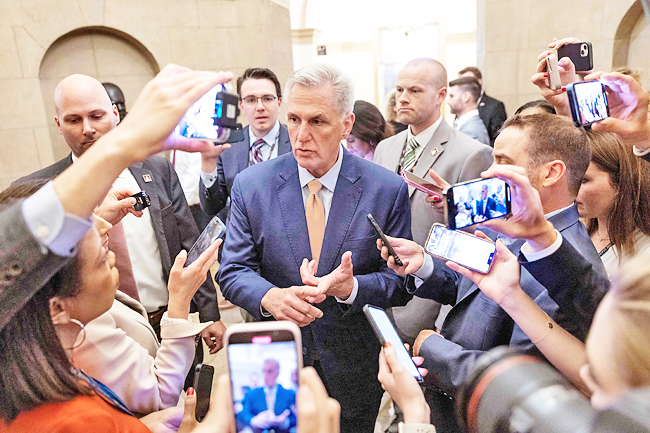WASHINGTON (AP) – Pushing to strike a debt ceiling deal, the United States (US) Republican negotiating team headed on Wednesday to the White House for more discussions with the sides still far apart.
Time is short. The White House and House Republicans are working to reach a budget compromise before June 1, when Treasury Secretary Janet Yellen has said the country could run out of cash to pay the nation’s bills.
A debt default would be potentially devastating for the US and global economy, depending on how long the standoff drags on.
White House estimates said a prolonged default could cause 8.3 million job losses and a world-shaking recession.
McCarthy and Republicans are insisting on spending cuts in exchange for raising the debt limit. Biden has come to the negotiating table after balking for months but saidthe GOP lawmakers will have to back off their “extreme positions”.
A look at the negotiations and why they are happening:
WHAT IS THE DEBT CEILING FIGHT ALL ABOUT?
Once a routine act by Congress, the vote to raise the debt ceiling allows the Treasury Department to continue borrowing money to pay the nation’s already incurred bills.
The vote in more recent times has been used as a political leverage point, a must-pass bill that can be loaded up with other priorities.

House Republicans are refusing to raise the debt limit unless Biden and the Democrats impose federal spending cuts and restrictions on future spending.
The Republicans said the nation’s debt, now at USD31 trillion, is unsustainable. They also want to attach other priorities, including stiffer work requirements on recipients of government cash aid, food stamps and the Medicaid health care programme. Many Democrats oppose those requirements.
Biden had insisted on approving the debt ceiling with no strings attached, saying the US always pays its bills and defaulting on debt is non-negotiable.
But facing the prospect of the government running out of money to cover all its bills, Biden launched negotiations with Republicans.
IS IT CLOSE TO BEING RESOLVED?
The talks have been a weeks long see-saw of positive signs and rocky moments. They are at odds over how to trim annual budget deficits.
Republicans are determined to cut spending while Biden’s team offered to hold spending levels flat.
Biden wants to increase some taxes on the wealthiest Americans and big companies, but McCarthy said early on that that is out of the question. But reaching an agreement is only part of the challenge.
Any deal would also have to pass the Repulican-led House and Democratic-majority Senate with significant bipartisan support.
WHAT ARE THE HANGUPS?
Republicans have dropped their demand to roll back spending to 2022 levels but said spending next year 2024 must be less than it is today. They also want to cap spending for the next decade.
Democrats aren’t willing to go that far to actually cut federal spending. The White House has instead proposed freezing spending at the current 2023 levels.
There are also policy priorities under consideration, including steps that could help speed the construction and development of energy projects that both Republicans and some Democrats want.
Democrats have strenuously objected to a Republican push to impose stiffer work requirements.
WHAT IS THE TIMELINE FOR ALL THIS?
Treasury said it will run out of money as soon as June 1. Yellen said on Wednesday it’s “almost certain” the US would default by early June if no action is taken. It’s hard to pinpoint an exact date the government would start missing payments.
McCarthy has promised that he will allow 72 hours for lawmakers to look over any proposed deal before it is brought for a vote, so the soonest the House could vote at this point is over the weekend.
It would then have to go to the US Senate next week, where Senate Majority Leader Chuck Schumer has said it could pass more quickly. And before the legislative text can be reviewed, it needs to be written and a deal needs to be made.
WHAT HAPPENS IF THEY DON’T RAISE THE DEBT CEILING?
A government default would be unprecedented and devastating to the nation’s economy. Yellen and economic experts have said it could be “catastrophic”.
There isn’t really a blueprint for what would happen. But it would have far-reaching effects.
Yellen said it would destroy jobs and businesses and leave millions of families who rely on federal government payments to “likely go unpaid”. More than eight million people could lose their jobs, government officials estimate. The economy could nosedive into a recession.
IS THERE A BACKUP PLAN IF TALKS FAIL?
Some Democrats want Biden to raise the debt ceiling on his own.
Progressives have urged Biden to invoke a clause in the Constitution’s 14th Amendment that said the validity of the public debt in the US “shall not be questioned”. Default, the argument goes, is therefore unconstitutional.
Supporters of unilateral action say Biden already has the authority to effectively nullify the debt limit. The president has resisted that option, which raises legal issues.
In Congress, meanwhile, House Democratic leader Hakeem Jeffries has launched a process that would “discharge” the debt ceiling issue to the House floor forcing a vote on raising the limit. That, however, is an unlikely option as a handful of Republicans would have to defy McCarthy and their leadership to join the Democrats’ effort.







